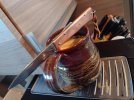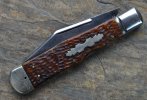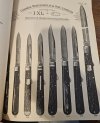Absorbing thread, it's a common misconception that Buck somehow started Lockbacks due to the phenomenal success of its iconic 110 model but as we can see, it's far from the case. American, English, French, German and maybe others were making these in the c19th.
Levine (1985, p164.) has this to say " Since the mid - 19th century, the swell-center regular jack handle die has been used for lockback folding hunters. These attractive knives usually have a single clip blade. The only old names I have seen for these knives are "lock knife" and "hunting knife" , which both referred to other patterns as well.
In the 1920s and 1930s, Remington and Utica made single-bladed folding hunters on their swell-center regular large trapper handles."
He shows pictures of these and on previous page 162 a monster Miller Bros. at 5 3/8" The later Remingtons begin to have the lock tab further back on the handle as we usually find Lockbacks today, earlier this was in the middle (Case Copperlock style) or as a raised almost lever like affair. Often Sabre grind was employed
As ever, the exact history of the Lockback is murky. Levine (1975, p.275.) has an illustration from an 1816 catalogue by Smith's Key, Sheffield of two knives that are Lockback (they are Spear blade and look similar to the French pattern known as Pradel.) Interestingly, some of the knives are described as 'spotted knives' meaning clear horn spotted to resemble Tortoise (ever the costly scale) He also refers to Folding Dirks & Bowies from Sheffield and later Germany pp.170-172 which are locking. Some of the values of these folding Bowies from the 1830s are eye watering 3,500-5000 USD and this is near 50 years ago. Butcher, Wostenholm, Wragg, Mills (London). One wonders how well those values have stood up, knife collecting a notoriously fickle and unreliable 'investment'

(Please, no lecture from a pedant here about 'we don't discuss prices...


' this is relative and relevant )
Levine also argues that by the 1940s larger Lockbacks had been mainly displaced by fixed blades and small Lockbacks would be a relatively new idea as these were perceived as large working knives. Hence, Buck 'revived' the old spirit with its successful 110.
Thanks, Will




